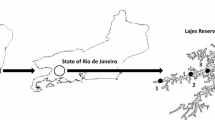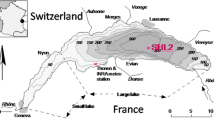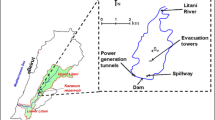Abstract
Forecasting models for Anabaena, Aphanizomenon and Microcystis have been developed for the hypertrophic phase from 1979 to 1990 and the eutrophic phase from 1997 to 2012 of the polymictic Lake Müggelsee by means of the hybrid evolutionary algorithm HEA. Comparisons of limnological parameters of the two phases revealed not only a distinct seasonal extension of N-limitation but also higher water temperatures that rose earlier and lasted longer between spring and autumn from 1997 to 2012. These differences were reflected by threshold conditions and sensitivity functions of the cyanobacteria-specific models evolved by HEA for the two phases. Seven-day-ahead forecasts matched well timings of peaking biomass observed for the three cyanobacteria but partially failed to predict accurate magnitudes, whereby coefficients of determination r 2 ranged between 0.48 and 0.76 for models in Phase I and between 0.42 and 0.69 in Phase II. The threshold conditions of the models quantified ranges of key predictor variables such as water temperature and transparency, concentrations of NO3-N and PO4-P that were symptomatic for sudden outbreaks of high biomass of the three cyanobacteria. Sensitivity functions extracted from 20 best performing models for each of the three cyanobacteria in both phases indicated different abundances between N-fixing Anabaena and Aphanizomenon compared to non-N-fixing Microcystis in response to strengthened N-limitation in Phase II.










Similar content being viewed by others
References
Adrian, R., R. Deneke, U. Mischke, R. Stellmacher & P. Lederer, 1995. A long-term study of Heiligensee (1975–1992). Evidence for effects of climate change on the dynamics of eutrophied lake ecosystems. Archive for Hydrobiology 133: 315–337.
Adrian, R., C. M. O’Reilly, H. Zagarese, S. B. Baines, D. O. Hessen, W. Keller, D. M. Livingstone, R. Sommaruga, D. Straile, E. van Donk, G. A. Weyhenmeyer & M. Winder, 2009. Lakes as sentinels of climate change. Limnology and Oceanography 54: 2283–2297.
Adrian, R., D. Gerten, V. Huber, C. Wagner & S. R. Schmidt, 2012. Windows of change: temporal scale of analysis is decisive to detect ecosystem responses to climate change. Marine Biology 159: 2533–2542.
APHA, 2005. Standard Methods for the Examination of Water and Wastewater, 21st ed. American Public Health Association, Washington, DC.
Cao, H., F. Recknagel & P. Orr, 2013. Enhanced functionality of the redesigned hybrid evolutionary algorithm HEA demonstrated by predictive modelling of algal growth in the Wivenhoe Reservoir, Queensland (Australia). Ecological Modelling 252: 32–43.
Cao, H., F. Recknagel & P. T. Orr, 2014. Parameter optimisation algorithms for evolving rule models applied to freshwater ecosystem. IEEE Transactions on Evolutionary Computation 18(6): 793–806.
Huber, V., R. Adrian & D. Gerten, 2008. Phytoplankton response to climate warming modified by trophic state. Limnology and Oceanography 53(1): 1–13.
Elliott, J. A., I. D. Jones & S. J. Thackeray, 2006. Testing the sensitivity of phytoplankton communities to changes in water temperature and nutrient load, in a temperate lake. Hydrobiologia 559: 401–411.
Holland, J. H., 1975. Adaptation in Natural and Artificial Systems. University of Michigan Press, Ann Arbour, MI.
Holland, J.H., et al., 1986. Induction. Process of Inference, Learning, and Discovery. MIT Press, Cambridge.
Huber, V., R. Adrian & D. Gerten, 2010. A matter of timing: heat wave impact on crustacean zooplankton. Freshwater Biology 55: 1769–1779.
Huber, V., C. Wagner, D. Gerten & R. Adrian, 2012. To bloom or not to bloom: contrasting responses of cyanobacteria to different heat waves explained by critical thresholds of abiotic drivers. Oecologia 169: 245–256.
Huisman, J., J. Sharples, J. M. Stroom, P. M. Visser, W. E. A. Kardinaal, J. M. H. Verspagen & B. Sommeijer, 2004. Changes in turbulent mixing shift competition for light between phytoplankton species. Ecology 85: 2960–2970.
Jöhnk, K. D., J. Huisman, J. Sharples, B. Sommeijer, P. M. Visser & J. M. Stroom, 2008. Summer heatwaves promote blooms of harmful cyanobacteria. Global Change Biology 14: 495–512.
Köhler, J., H. Behrendt & S. Hoeg, 2000. Long-term response of phytoplankton to reduced nutrient load in the flushed Lake Müggelsee (Spree system, Germany). Archiv für Hydrobiologie 148: 209–229.
Köhler, J., S. Hilt, R. Adrian, A. Nicklisch, H. P. Kozerski & N. Walz, 2005. Long-term response of a shallow, moderately flushed lake to reduced external phosphorus and nitrogen loading. Freshwater Biology 50: 1639–1650.
Livingstone, D. M. & R. Adrian, 2009. Modeling the duration of intermittent ice cover on a lake for climate-change studies. Limnology and Oceanography 54(5): 1709–1722.
Mooij, W. M., L. N. De Senerpont Domis & J. H. Janse, 2009. Linking species- and ecosystem-level impacts of climate change in lakes with a complex and a minimal model. Ecological Modelling 220: 3011–3020.
Paerl, H. W., 1988. Nuisance phytoplankton blooms in coastal, estuarine and inland waters. Limnology and Oceanography 33: 823–847.
Recknagel, F., M. Hosomi, T. Fukushima & D.-S. Kong, 1995. Short- and long-term control of external and internal phosphorus loads in lakes—a scenario analysis. Water Research 29(7): 1767–1779.
Recknagel, F., H. Cao, C. van Ginkel, D. van der Molen, H. Park & N. Takamura, 2008. Adaptive agents for forecasting seasonal outbreaks of blue-green algal populations in lakes categorised by circulation type and trophic state. Verhandlungen Internationale Verein Limnologie 30(2): 191–197.
Recknagel, F., I. Ostrovsky, H. Cao, T. Zohary & X. Zhang, 2013. Ecological relationships, thresholds and time-lags determining phytoplankton community dynamics of Lake Kinneret, Israel elucidated by evolutionary computation and wavelets. Ecological Modelling 255: 70–86.
Recknagel, F., I. Ostrovsky & H. Cao, 2014a. Model ensemble for the simulation of plankton community dynamics of lake Kinneret (Israel) induced from in situ predictor variables by evolutionary computation. Environmental Modelling & Software 61: 380–392.
Recknagel, F., P. Orr & H. Cao, 2014b. Inductive reasoning and forecasting of population dynamics of Cylindrospermopsis raciborskii in three sub-tropical reservoirs by evolutionary computation. Harmful Algae 31: 26–34.
Recknagel, F., I. Ostrovsky, H. Cao & Q. Chen, 2014c. Hybrid evolutionary computation quantifies environmental thresholds for recurrent outbreaks of population density. Ecological Informatics 24: 85–89.
Reynolds, C., 1984. The Ecology of Freshwater Phytoplankton. Cambridge University Press, Cambridge.
Storn, R. & K. Price, 1997. Differential evolution—A simple and efficient heuristic for global optimization over continuous spaces. Journal of Global Optimization 11: 341–359.
Utermoehl, H., 1958. Zur Vervollkommnung der quantitativen Phytoplankton Methodik. Mitt. Internationale Ver. Theoretische und Angewandte Limnologie 9: 1–38.
Wilhelm, S. & R. Adrian, 2008. Impact of summer warming on the thermal characteristics of a polymictic lake: consequences for oxygen, nutrients and phytoplankton. Freshwater Biology 53: 226–237.
Wagner, C. & R. Adrian, 2009. Cyanobacteria blooms: quantifying the effects of climate change. Limnology and Oceanography 54(6): 2460–2468.
Acknowledgements
We thank two anonymous reviewers for their instructive comments that have significantly improved the manuscript. This research was partially funded by the EU Project LIMNOTIP under the FP7 ERA-Net Scheme (Biodiversa 01LC1207A).
Author information
Authors and Affiliations
Corresponding author
Additional information
Guest editors: M. Beklioğlu, M. Meerhoff, T. A. Davidson, K. A. Ger, K. E. Havens & B. Moss / Shallow Lakes in a Fast Changing World
Rights and permissions
About this article
Cite this article
Recknagel, F., Adrian, R., Köhler, J. et al. Threshold quantification and short-term forecasting of Anabaena, Aphanizomenon and Microcystis in the polymictic eutrophic Lake Müggelsee (Germany) by inferential modelling using the hybrid evolutionary algorithm HEA. Hydrobiologia 778, 61–74 (2016). https://doi.org/10.1007/s10750-015-2442-7
Received:
Revised:
Accepted:
Published:
Issue Date:
DOI: https://doi.org/10.1007/s10750-015-2442-7




